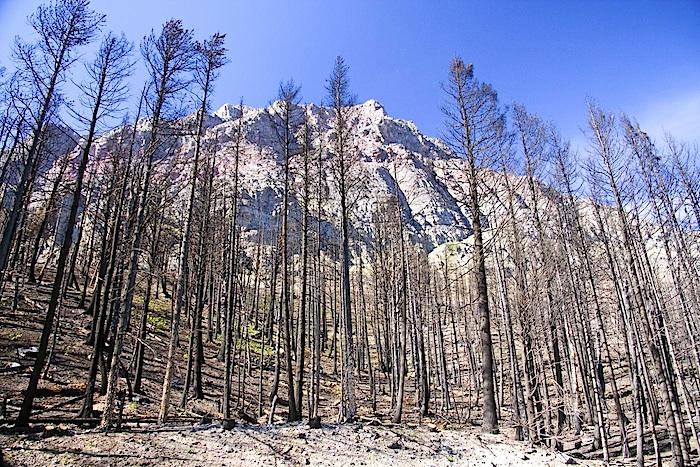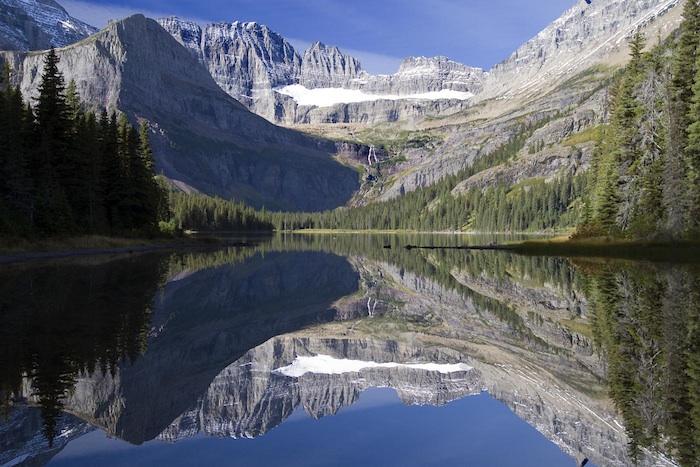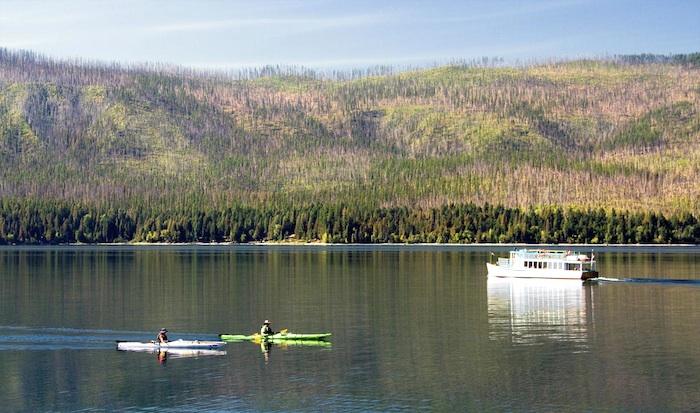
The landscape burned by the Reynolds Creek Fire in 2015 will take many decades to regrow to a mature forest/George Oxford Miller
Climate Change Cataclysms Accelerate The Pace Of Change In Our National Parks
Stepping out at of my car at the overlook of Lake St. Mary in Glacier National Park, I expect to smell the invigorating aroma of a spruce-fir forest. Instead I smell ashes. The conifer forest is no more, and won’t be again in my lifetime, or my children’s.
On July 21, 2015, the human-caused Reynolds Fire swept the northern slope above the lake and burned 4,000 acres. Looking across the scenic, glacier-carved lake, I see a forest of dead-standing trees from the 2006 Red Eagle Fire that charred 34,000 acres on the southern shore.
Historically, the icy chisel of mile-thick glaciers carved the mountain valleys and lakes that make Glacier one of the most spectacular parks in the West. In the last century, an increasingly warming climate has melted all but 25 of the 150 glaciers that existed in 1850, but that’s not the only change.
The stress of mega-droughts associated with climate change weakens trees. Long, hot summers causes bark beetle and spruce bud worm population explosions that decimate the forests, and decades of human fire suppression create perfect conditions for mega fires unlike any ever seen.
“This summer has been the driest on record and one of the hottest,” a ranger in Many Glaciers told me. “Forest fires are more frequent and more intense. Decades of fires have completely changed the ecology of much of the park. Computer models project that all the glaciers will totally disappear by 2030.”
Much of the Going to the Sun Road passes through slopes burned in the last decade or so.
“2003 was a big fire year,” a ranger at the West Entrance told me. “Six major fires burned 135,000 acres. The Robert Fire burned 57,000 acres on the west side of Lake McDonald. The Trapper Fire burned 20,000 acres around the Loop on the Going to the Sun Road. Thirteen percent of the park burned.”

The dwindling Grinnell Glacier once covered the slopes down to waterfall above Lake Josephine/George Oxford Miller
Past conflagrations have threatened, but never burned, the historic lodges in the park. The town of West Glacier and Lake McDonald Lodge, built in 1913, were evacuated during the fires of 2003, and the Rising Sun Motor Lodge and much of the east side of the park was closed during the fires of 2015. The beautiful Many Glaciers Lodge, overlooking Swiftcurrent Lake, was unharmed and is celebrating its 100th birthday in 2105. Photos on the walls of glaciers taken when the hotel was built and current photos illustrate the dramatic effects of climate warming.
After hiking the Avalanche Lake trail through 500-year-old conifer forest, we follow the Rocky Point Trail through the Robert Fire zone on the west shore of Lake McDonald. The difference between scrubby regrowth and towering mature forests is staggering. More telling is the even-aged lodgepole pine mono-forest from a burn in 1929 around the Apgar Visitor Center compared with the old-growth forests. Nature may repair itself, but at its own pace.
From mixed-grass prairies to high-desert pinyon-juniper woodlands and mountain conifer forests, periodic fires have always been integral to maintaining the biodiversity of a healthy ecosystem. Yet the super fires now ravaging the West destroy instead of maintaining healthy plant communities.
According to the National Interagency Fire Center, wildland fires have burned 9,276,416 acres in 2015, with 37 large fires in six states. Besides Glacier, significant fires occurred in Sequoia-Kings Canyon (151,623 acres), Crater Lake (20,960 acres), and even in Olympic National Park’s Hoh Rain Forest (2,800 acres), which had the driest year on record. Only three other years have topped 9 million acres burned: 2006, 2007, 2012. The ten-year average is 6,350,289 acres per year consumed by fire.
“Fire and ice create a really interesting mix that dynamically changes the forests all the time,” the West Entrance ranger said.
The faces of our Western national parks change yearly, all the more reason to protect and savor the majesty of our nation’s most spectacular parks at every opportunity.

In 2003, the Robert Fire burned 57,570 acres along the west shore of Lake McDonald/George Oxford Miller



Add comment